How to Find Gold: Prospecting, Panning and Mining for Gold

A Quick Introduction to Gold Prospecting & Panning
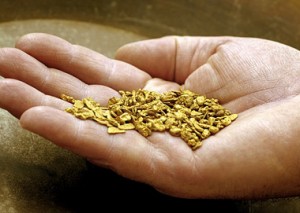 Recreational gold prospecting is quickly becoming a popular, profitable outdoor pastime for amateur treasure hunters with gold fever in the United States and other countries around the world.
Recreational gold prospecting is quickly becoming a popular, profitable outdoor pastime for amateur treasure hunters with gold fever in the United States and other countries around the world.
With nothing more than a simple gold pan and a few other inexpensive tools, amateur gold hunters across the country are discovering the joy of mining for gold and making money in the process. And panning for gold isn’t just limited to western states . . . regardless of where you live, there is probably a place nearby where you can buy some simple equipment and start learning how to prospect for gold in streams.
Amateur gold hunting is nothing like the big, expensive undertaking of large-scale commercial gold mine prospecting. When a company is looking for deep placer gold deposits, methods such as drilling and trenching are often used that require high-dollar equipment and employees to run it. Commercial prospecting involves sampling and assaying gold deposits, can even require high-tech methods like magnetic, gravity and seismic geophysical surveying.
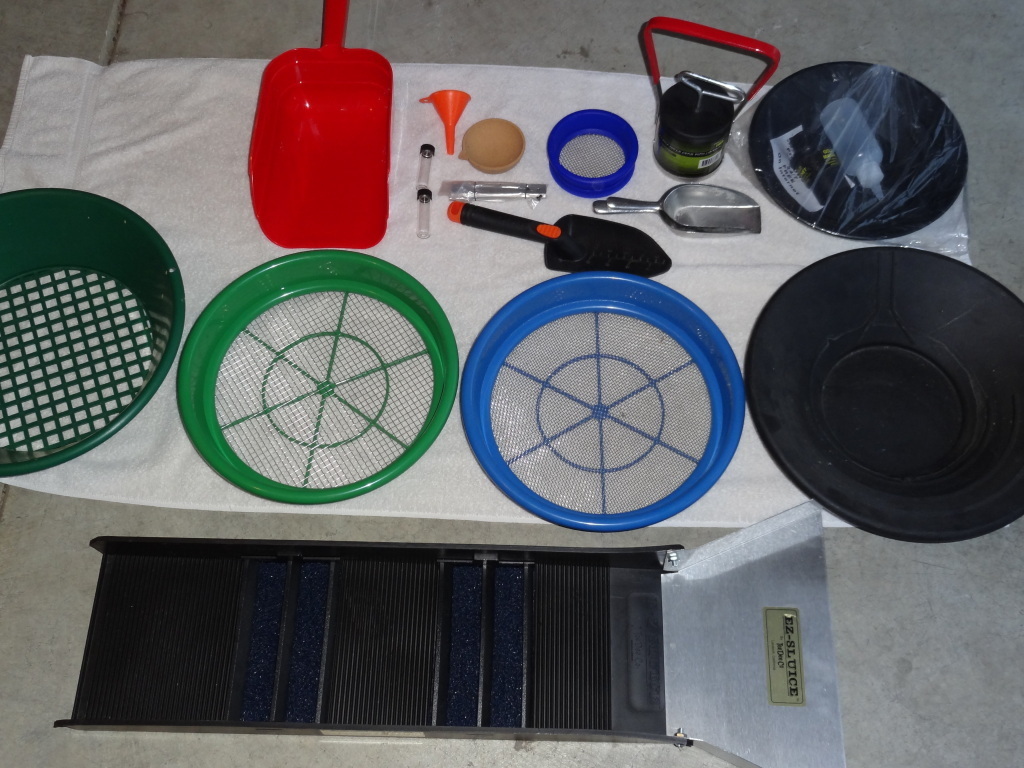
A typical beginner’s gold prospecting kit that can be bought online.
Recreational panning, however, can be done easily and inexpensively. Even if you don’t get rich doing it or find a big nugget, prospecting for gold is a great way to have fun outdoors, learn a new hobby, and make a little extra money in the process.
How to Pan for Gold: A Simple Step-By-Step Primer
Planning Ahead for Successful Gold Prospecting
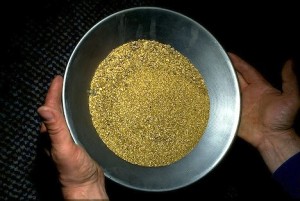 First of all, it’s important to remember that you aren’t going to simply pan gold out of any random stream. It pays to do a small amount of research and identify places where people have successfully prospected for gold already.
First of all, it’s important to remember that you aren’t going to simply pan gold out of any random stream. It pays to do a small amount of research and identify places where people have successfully prospected for gold already.
The basic concept behind hunting for gold and panning it out of a stream is simple: gold is heavy. It stays at the bottom of a stream and often accumulates in sand located near the shore and banks, bends in the stream, and cracks and crevices in rocks. When panning for gold, you’re simply trying to get that heaviest material–the gold–to filter down into the bottom of the pan you’re using.
Before you start prospecting, take some time to find the best place along the stream to pan. Pick a spot where the water doesn’t move very quickly, because fast-flowing water could potentially wash gold out of your pan. Some flow is vital, however, so that you can keep the water clear of sediment and sand for a clear view while you’re panning.
The Process of Panning for Gold
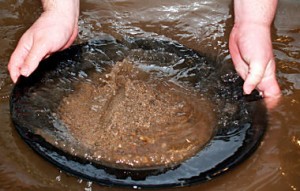 Start by putting a limited amount of gravel and dirt into the pan (only fill the pan up about one-fourth to one-half of the way). Dip the pan into the water to get your material wet, then shake it around pretty hard side-to-side and in a circular fashion (make sure you don’t wash away much of the material when you’re doing this initial shaking). This will make heavy stuff in the pan go to the bottom, and lighter materials rise up.
Start by putting a limited amount of gravel and dirt into the pan (only fill the pan up about one-fourth to one-half of the way). Dip the pan into the water to get your material wet, then shake it around pretty hard side-to-side and in a circular fashion (make sure you don’t wash away much of the material when you’re doing this initial shaking). This will make heavy stuff in the pan go to the bottom, and lighter materials rise up.
These lighter materials are worthless, so you can take out the larger rocks and pebbles that rise to the top, while breaking apart clumps of clay and dirt. This process of shaking and removing lighter materials from your pan is called “stratifying,” and you’re going to repeat it quite a few times in hopes of making sure that valuable gold is the last thing to remain at the bottom of the pan.
While you are rocking your pan back and forth to get the gravel and dirt to the top, your view will get obscured by the mucky water . . . that’s why we chose an area in the stream that still had some gentle water current flow. You can (carefully) dip the pan into the water and let the flow carry off the muddy water, dirt and gravel to clear your view of the material in the pan.
Now you can lift your pan up out of the stream while making sure there is still some water mixed in with the material. While tilting the pan forward, shake it gently to make the gold settle down into the bottom of the pan. When doing this, be careful not to let the material wash away over the lip of the pan!
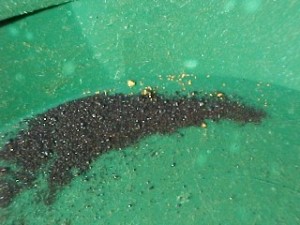 As you continue repeating this rinsing, rocking and shaking pattern with your pan, you’ll end up with a little bit of material in the bottom of the pan that will get progressively darker (this is because the heavy material is mainly made up of iron). Keep rinsing out material from your pan until all that is left is black (iron) sand. Remember: take your time! It’s going to take you a while to get a feel for panning, and you’ll get better at it with practice.
As you continue repeating this rinsing, rocking and shaking pattern with your pan, you’ll end up with a little bit of material in the bottom of the pan that will get progressively darker (this is because the heavy material is mainly made up of iron). Keep rinsing out material from your pan until all that is left is black (iron) sand. Remember: take your time! It’s going to take you a while to get a feel for panning, and you’ll get better at it with practice.
As you remove more and more of the lighter, worthless material from your pan, you may start to see bright flakes of gold standing out against the dark iron sand. Keep gently shaking the pan to get rid of the unwanted material until you have only a few spoonfuls of black sand left.
Many amateur gold prospectors take this black sand home in order to complete the process of separating and removing the gold flakes. One frequently used tool in separating the black iron sand from the gold is a magnet, which will attract the iron and leave other materials behind.
Gold Panning How-To Video
Here’s a good video of a gold panner showing you how to do it the right way:

